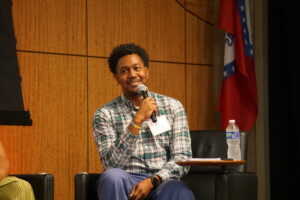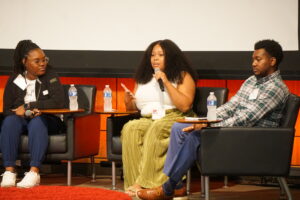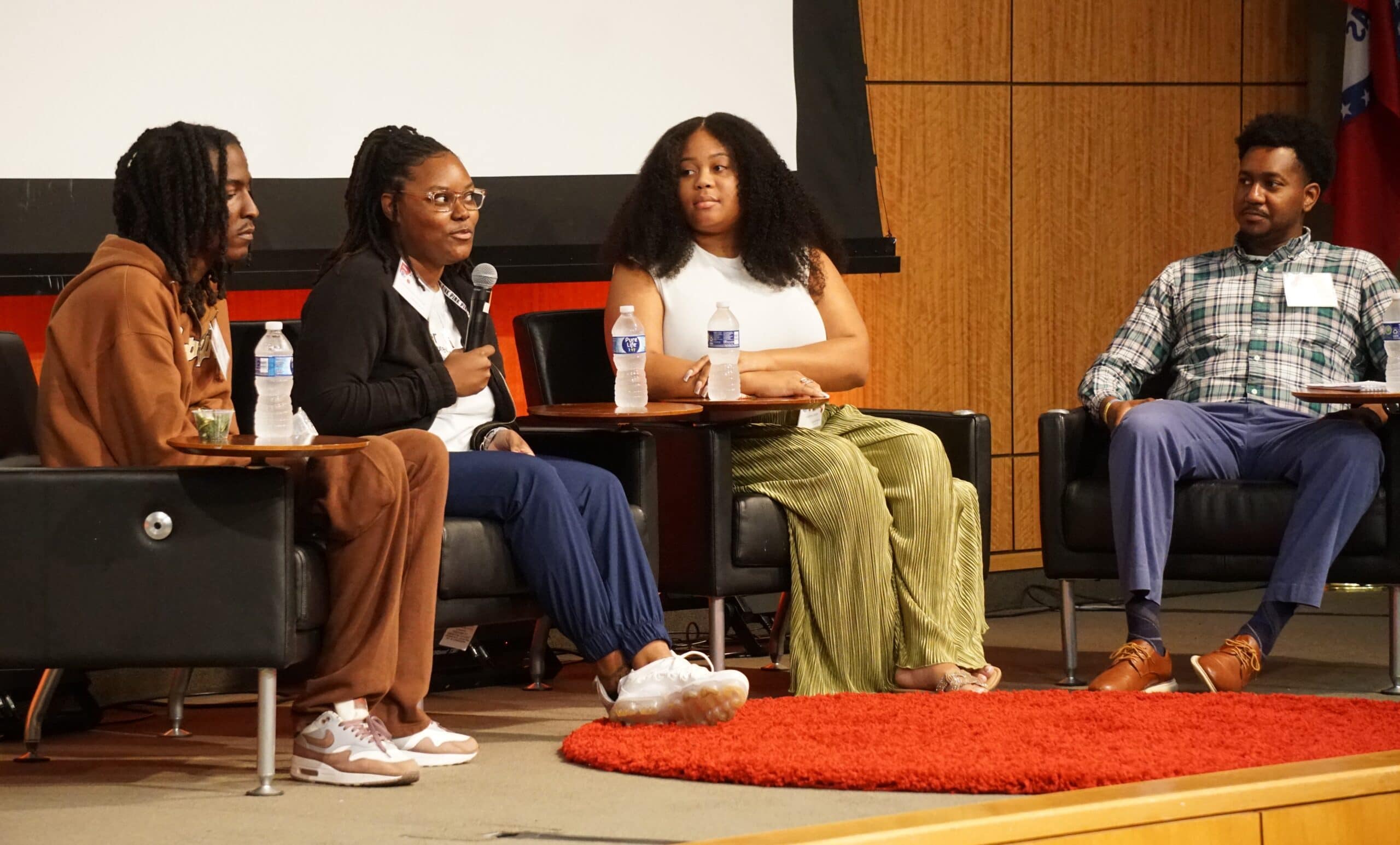UAMS Adult Sickle Cell Program Celebrates 10th Anniversary at Annual Symposium
| The University of Arkansas for Medical Sciences (UAMS) Adult Sickle Cell Program celebrated a decade of providing care for patients across Arkansas during its annual symposium. Speakers at the event, which included several patients, reflected on the past while looking with hope toward the future.
The Sept. 19 event was held on the 12th floor of the UAMS Jackson T. Stephens Spine & Neuroscience Institute in Little Rock and livestreamed on Zoom, drawing 78 total attendees.

Phillip Sanders, whose sickle cell disease was cured in 2020 following a bone marrow transplant, talks about his journey as a patient.Benjamin Waldrum
The UAMS Adult Sickle Cell Program was established in 2014 with support from the Arkansas Legislature, Medicaid and the Arkansas Minority Health Commission. Since then, the program has helped treat hundreds of patients and families. It collaborates with the pediatric Sickle Cell Disease Program at Arkansas Children’s and often receives patients when they age out of the program. Overall, the UAMS program maintains more than 250 active patients across the state.
“I am proud of the work that the UAMS Adult Sickle Cell Program has done over the past 10 years to provide continuation of care for hundreds of sickle cell patients across Arkansas,” said Sunny Singh, M.D., the program’s director. “I want to thank every member of our staff, as well as our community partners, and, of course, our patients for entrusting their care to us. I look forward to what advances in care the next decade will bring.”
Singh added thanks for many others at UAMS, including Gina Drobena, M.D., and the Division of Transfusion Services in the College of Medicine Department of Pathology; Muthu Veera Kumaran, M.D., and the Winthrop P. Rockefeller Cancer Institute’s bone marrow transplant program; hospitalists at the Cancer Institute’s Myeloma Center; the Division of Hematology and Oncology; as well as the Emergency Department, medical ICU, internal and family medicine staff, nurses, social workers and care coordination staff. He also thanked the Institute for Digital Health & Innovation, which oversees the adult sickle cell program.

Alyssa Frisby explains the benefits of healthier cooking at the sickle cell symposium.Benjamin Waldrum
Each year, the UAMS symposium brings together leading researchers, clinicians, patients and community advocates to share advancements in sickle cell disease research and treatment, identify current challenges and develop strategies to accelerate progress towards a cure.
Sickle cell disease is a group of inherited red blood cell disorders where the red blood cells become hard and sticky, resulting in a C-shape or “sickle.” When sickle cells travel to small blood vessels, they get trapped and block blood flow to the area. This results in pain and may lead to other problems such as infection, acute chest syndrome and stroke.
Approximately 100,000 Americans are affected by sickle cell disease, according to the Centers for Disease Control and Prevention. About 60% of those are adults. There are more than 1,000 Arkansans with sickle cell disease, with roughly 20 new cases detected each year. The overwhelming majority of patients with sickle cell disease are Black.
The symposium hosted multiple presentations on care and treatment for sickle cell disease:
- Keesha Powell-Roach, Ph.D., assistant professor at the University of Tennessee Health Science Center, with joint appointments in its Colleges of Nursing and Medicine, presented on the science of pain and how it affects patients with sickle cell disease.
- Pat Carroll, M.D., director of psychiatric services for the Johns Hopkins University Sickle Cell Center for Adults and an associate professor of psychiatry and behavioral sciences, presented on the underreported link between sickle cell disease and depression.
- Dominique Bulgin, Ph.D., RN, assistant professor of nursing at the University of Tennessee College of Nursing, presented on implicit bias, and how it often results in stigmas that make it harder for patients with sickle cell disease to obtain care.
Following the presentations, attendees and speakers filed out into the lounge area for a cooking demonstration by members of UAMS Culinary Medicine. Alyssa Frisby, M.S., RD, LD, brand manager for the program and an instructor in the UAMS Office of Academic Affairs, shared ways to make healthier choices and served samples of the dishes she made.
Stella Bowers, RN, sickle cell program coordinator, led a patient-focused panel to close the event. Marcus Johnson, Gabrielle Brumfield, Andrea Oates and Phillip Sanders took turns sharing their experiences as patients with sickle cell disease and the difficulties they’ve faced. Each patient mentioned long waits in emergency departments while in extreme pain, along with hospital stays that lasted several days.
“Growing up, you think you can do what normal people can do, then you realize you can’t,” said Johnson, who has sickle cell beta thalassemia, a form of sickle cell anemia. “A lot of your dreams, you have to put to the side.”

Andrea Oates speaks on her experience as a sickle cell patient, which included being told to keep working during a pain crisis.Benjamin Waldrum
Johnson said that in his experience, medical staff often doesn’t take his pain seriously. “They don’t really know how much pain you go through,” he said.
Employers also struggle to understand. “With employment, it’s hard having your administrators understanding what it is you go through, because all they see is, ‘Oh, you just can’t be at work today.’ They don’t understand the pain that comes behind it, or the mentality that I want to be there, but I physically cannot,” Oates said.
Once, Oates said she had a pain crisis and needed to go home, but her workplace refused and told her to keep working, offering a bed in a back room for a short rest. “That is the worst thing that you can tell to a person when they straight up tell you, ‘I cannot be here,’” she said.
As each patient told their story, the others nodded in agreement. The common thread among all four of them was that patients with sickle cell are often misunderstood due to the unseen nature of their disease, along with racial bias and stigmas about seeking drugs.
Patients and program staff took questions from the audience following the panel. Singh, in response to one question, emphasized the need for early and continued education among providers. He said that some areas of medicine are taught very well, such as coronary disease, while others are less well understood. He added that sickle cell disease should be taught at all levels of medical education.
“From the very beginning, CPR is driven into our minds, and it becomes second nature — but that is not the case with sickle cell disease,” Singh said. “And if you work at any hospital in the country, you will see sickle cell patients.”
Singh listed various barriers to care, including a lack of standardization for sickle cell care nationwide, in addition to different levels of knowledge in providers, which can vary from shift to shift. This makes treating patients more complicated than it should be, he said.
“You learn, right? If you’re interested, you learn,” Singh said. “The system has to ensure that you learn before you leave training, and the same would apply for nursing and other areas. Unless we start [sickle cell education] at the medical school level, and it is repeated constantly throughout their training, it’s difficult to achieve that level of understanding among physicians. That is what it comes down to: education.”
